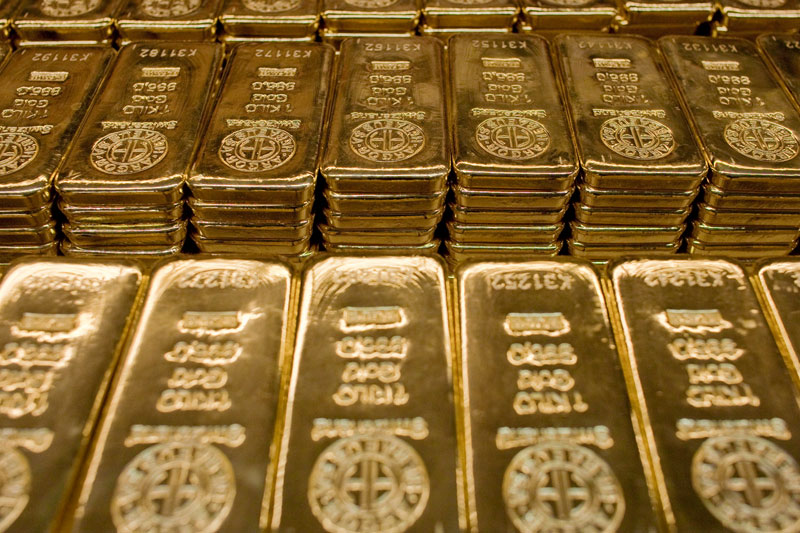Investing.com - Gold eased in Asia on Friday with China's stock markets volatile, but recovering after an early sharp dip.
On the Comex division of the New York Mercantile Exchange, gold for February delivery fell 0.35% to $1,103.90 a troy ounce.
The Shanghai Composite plunged briefly after the open and rebounded to trade up 1.74% at the break. A week of volatility on the bourse spooked global markets.
The yuan rose Friday after the People's Bank of China set a stronger fixing for the first time in nine trading sessions.
The yuan last traded 0.06% stronger at 6.5887 against the dollar compared with Thursday's close of 6.5929. The PBOC this morning set the yuan fixing at 6.5636 compared with Thursday's 6.5646.
Monetary policy makers in Japan said steps take in the December Bank of Japan board meeting were adjustments to policy, not easing, as downside risks were noted, but not seen as heightened, according to a summary of minutes released on Friday.
"While the supplementary measures decided this time are not additional monetary easing, they enable the bank to steadily continue with quantitative and qualitative monetary easing (QQE) through smoother asset purchases and, if judged necessary, to make appropriate adjustments in a timely manner," the summary said.
"Since downside risks to the outlook for economic activity and prices have not increased, the bank should maintain the current guideline for money market operations."
The BoJ will release the full minutes of the December meeting on Feb. 3.
In Australia, the AIG construction index came in at 46.8 for December, below the previous month's level of 50.7. A drop below 50 signals contraction.
Also in Australia retail sales for November rose 0.4% as expected, while Japan average cash earnings were flat, with a 0.7% gain seen, and overtime pay came in at 1.10%.
The U.S. dollar index, which measures the greenback’s strength against a trade-weighted basket of six major currencies, was up 0.35% to 98.64.
Copper for March delivery fell 0.26% to $1.018 a pound, while silver futures eased 0.97% to $14.205 a troy ounce.
Overnight, gold surged on Thursday to a nine-week high, as investors piled into the safe-haven asset after the People's Bank of China surprisingly adjusted its fix on the yuan, causing equities to plunge and triggering the second halt of trading in the opening week of the year.
In overnight trading, China's benchmark Shanghai Composite Index plummeted 7% within a half-hour of the start of trading, prompting its second circuit breaker in the span of four days. Earlier, the PBOC set the midpoint of the yuan at 6.5646 against the dollar, 0.51% lower than the previous day's rate, representing the sharpest fall in the daily fixing since the currency's massive depreciation in mid-August. In Tuesday's session, the PBOC set the yuan's midpoint at 6.5314, its lowest level since February, 2011.
On Tuesday morning, the PBOC injected 130 billion yuan into the nation's open-market operations, its most since September, after weak manufacturing data last month sparked fresh concerns of a further slowdown in the world's second-largest economy. Then on Wednesday, Markit said China's Caixin services PMI index for December fell to a 17-month low at 50.2, its second-lowest level on record.
Some experts view the latest intervention by the Chinese central bank as a desperate move to jumpstart its flagging economy by bolstering exports. At Thursday's low of 6.60007 versus the dollar, the yuan fell to its lowest level against the greenback in five years.
The latest crash in Chinese equities mirrors a sell-off from late-August when the PBOC devalued the yuan by its highest amount in more than two decades, shocking equity markets worldwide. On August 11, the PBOC changed its mechanism for pricing the yuan's midpoint by simply basing it on the prior day's close. Previously, major state-owned banks nationwide submitted a CNY/USD exchange rate to the PBOC each morning, which calculated an average to determine the midpoint. Over the course of a trading day, the PBOC intervenes to prevent the exchange rate from drifting 2% above or below the midpoint. China's Foreign Exchange Trading System (CFETS) said Thursday the new midpoint pricing system has achieved its anticipated result and will be more market-oriented in the future, Reuters reported.
Investors also digested the release of the Federal Reserve's minutes from its December meeting, where the U.S. central bank reiterated that it will raise interest rates gradually this year, amid continuing worries of weak inflation. Last month, the Fed abandoned a seven-year zero interest rate policy by approving its first rate hike in nearly a decade.
